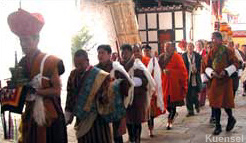 |
Bhutan's Culture - Dzongs |
 |
Bhutan Information |
|
|
 |
| Trongsa
Dzong: The Druk Minjur Chhoekhor Rabtentse Dzong |
| Trongsa
Dzong consecrated: A rich history restored |
 |
|
Completely
restored to its former glory in a major restoration and renovation project
begun in 1999,
the Trongsa Dzong was sanctified with the sacred consecration (rabney)
ceremony on October 28, 2004 corresponding to the 15th day of the ninth month of the Wood Monkey year.
The
former Je Khenpo, His Holiness Nyizer Trulku, Dorji Lopon Kuenley of
the central monk body, and the monks of the Chhoetse rabdey performed the Lama Chhoepa Rabney (dedicated to Guru Aradhana) and Gyalpoi ginseg (fire offering to remove obstacles) to sanctify the
magnificent monument.
The
rabney ceremony was attended by the prime minister, Lyonpo Yeshey Zimba, the home minister, Lyonpo Jigmi Y Thinley, Austrian ambassador
to Bhutan, Dr. Jutta Stefan-Bastl, senior Bhutanese and Austrian officials,
as well as representatives of the people of Mangdue Tshozhi. |
| The
Tashi Ngasol procession |
 |
| Tashi Ngasol ceremony |
| The
sacred rabney concluded with the unique Tashi Ngasol ceremony where
the entire gathering participated in an elaborate procession to circumambulate
the dzong. The procession, representing all life forms, carried the Tashi
Ta-gye (eight lucky signs), Tashi Ze-gye (eight precious objects),
and the Gyalse Ngaduen (seven treasures of a universal King), and
offered prayers in the ultimate celebration of the auspicious occasion. |
|
After
the ceremony, His Holiness Nyizer Trulku offered the Tashi Ze-gye to Prime Minister Lyonpo Yeshey Zimba.
The
renovation project was announced by His Majesty the King at the beginning
of the eighth five-year plan in 1997 following
several studies conducted by the Austrian government. The last renovation
on the Trongsa Dzong had been done in 1879 following damage caused by an earthquake.
About
Nu.100 million was spent on the renovation and restoration of the dzong,
75 percent of the funds from the government of Austria and the rest
funded by the government. According to the people of Mangdue Tshozhi the consecration of the Trongsa Dzong was not only a joyous occasion
but also an event that strengthened history and tradition.
"The Tashi
Rabney of the historic Trongsa Dzong is a re-enforcement of
the priorities and values that has survived and strengthened over the centuries,"
gup Phuentsho of Nubi geog reported. He said that the people of Trongsa
saw the renovation as an opportunity to preserve a part of Bhutanese history.
"The Trongsa dzong is a symbol of Bhutan's rich cultural and religious
heritage which we have inherited from our forefathers and it has a national
significance because it is where the institution of monarchy in Bhutan
began," said the secretary of Chhoetse Rabdey, Lopon Zeko who added
that the preservation of the Trongsa dzong was important to the
dzongkhag and the entire country. The dzong is home to the second largest
monastic body in the country.
 |
| Prime Minister Lyonpo Yeshey Zimba |
| The
sacred rabney concluded with the unique Tashi Ngasol ceremony where
the entire gathering participated in an elaborate procession to circumambulate
the dzong. The procession, representing all life forms, carried the Tashi
Ta-gye (eight lucky signs), Tashi Ze-gye (eight precious objects),
and the Gyalse Ngaduen (seven treasures of a universal King), and
offered prayers in the ultimate celebration of the auspicious occasion. |
|
The people
of Mangdue Tshozhi expressed their deep appreciation to the government
of Austria for funding the restoration of the historical dzong. "We
would like to express our appreciation to the Austrian government for providing financial support to renovate our Chhokhor Rabtentse Dzong,"
said gup Phuentsho and Lopon Zeko.
As
the oldest and one of the largest dzongs in Bhutan Lyonpo Yeshey Zimba
said that the Trongsa Dzong was of great importance to Bhutan as
it is where the institution of monarchy in Bhutan began. On behalf of the
royal government and people of Bhutan, Lyonpo Yeshey Zimba expressed his
appreciation to the government and the people of Austria for their
financial support to preserve and restore Trongsa dzong.
Austrian
Ambassador Dr. Jutta Stefan-Bastl said that the government of Austria
was happy for being able to contribute in preserving and restoring the
historical Trongsa dzong which is a symbol of Bhutan's rich cultural
and religious heritage. "I think we can tell our people back home about
the money spent on Trongsa dzong was well utilized and contributes
to the national identity and the cultural heritage of the Bhutanese people,"
said the ambassador.
| By
Rinzin Wangchuk, Kuensel, Bhutan's National Newspaper |
 |
| Information on Bhutan |
 |
|




